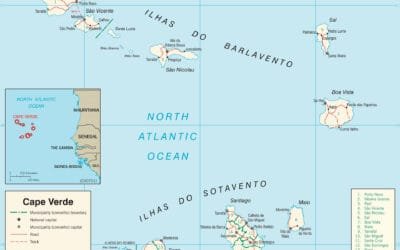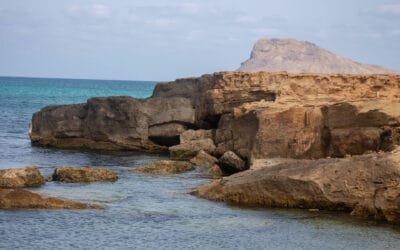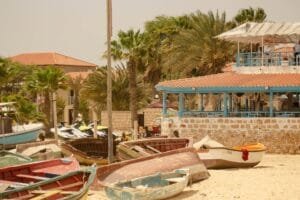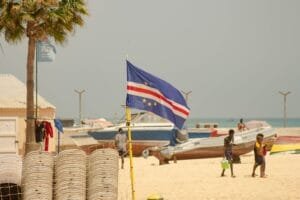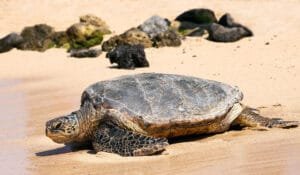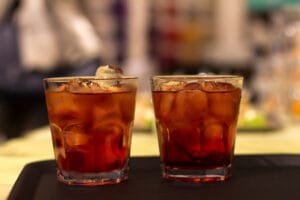Santa Maria: Walk Through The Most Popular Town
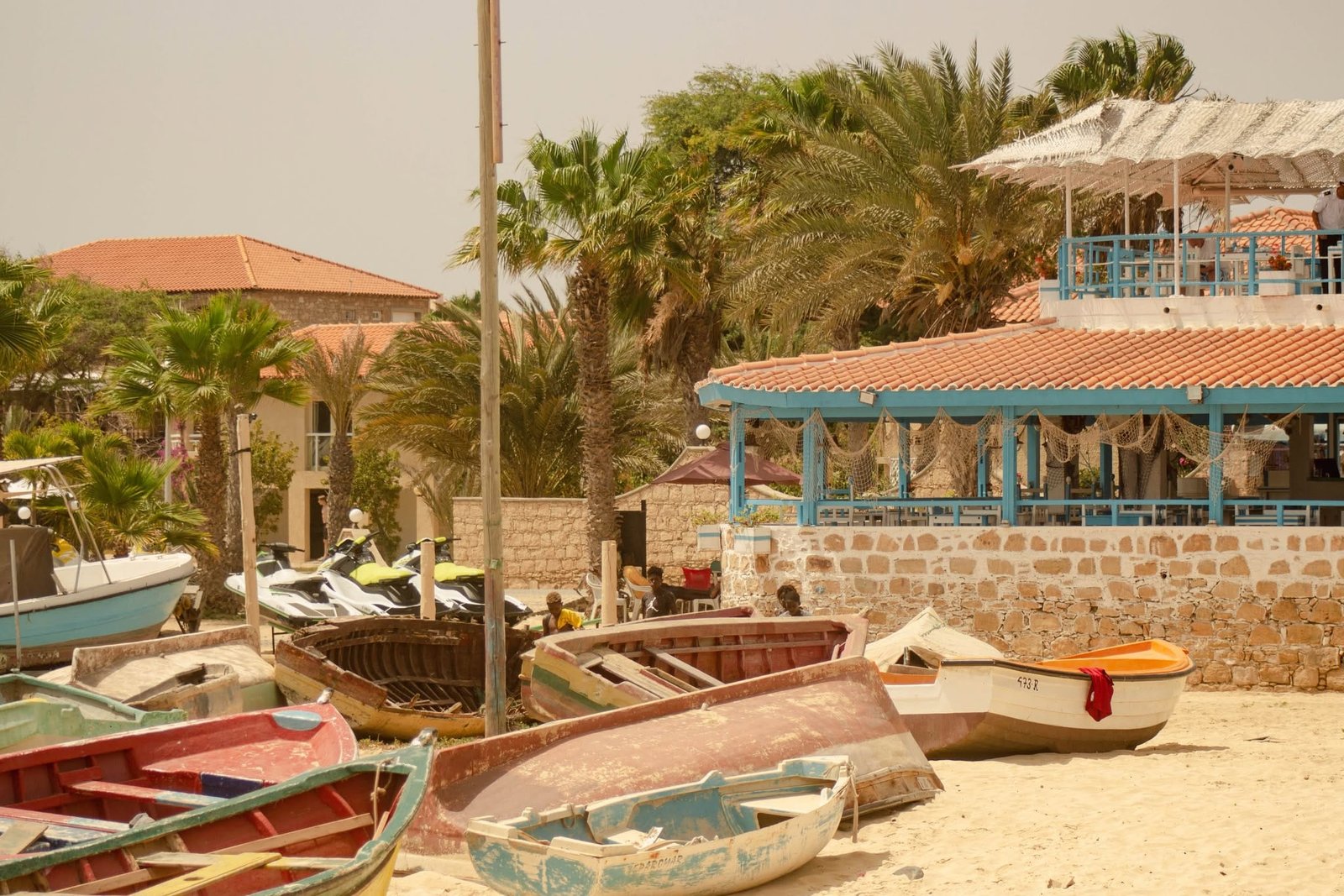
Santa Maria is a coastal town at the southern tip of Sal Island in Cape Verde, renowned for its beautiful beaches, azure ocean and year-round sunshine. What was once a sleepy fishing and salt-trading village has transformed into the island’s central tourist hub, while retaining a laid-back charm.
The town stretches along an 8-kilometre beach (Praia de Santa Maria) – often considered one of the seven natural wonders of Cape Verde – with calm turquoise waters and a backdrop of low dunes and pastel-colored buildings.
Despite its popularity, Santa Maria’s permanent population remains only around a few thousand residents (about 6,000 in 2010), giving it a friendly small-town feel even as it welcomes visitors from around the world.
The climate is arid and warm; temperatures average 22–27°C year-round with almost no rainfall, making it a year-round beach destination. Steady trade winds blow along Sal’s coast, keeping the air comfortable and providing ideal conditions for wind sports.
In Santa Maria, travellers will find a blend of African, Portuguese, and international influences – from Creole cuisine and morna music to European-style cafes – all set in a sun-drenched Atlantic setting.
Google Maps: Santa Maria, Cape Verde
Town’s History
Time of Salt
Founded in 1830 by Portuguese trader Manuel António Martins, Santa Maria began as a centre for salt production, which gave Sal (“salt” in Portuguese) Island its name. The town’s saltpans were developed to evaporate seawater, yielding up to 30,000 tons of salt per year in the 19th century. Salt was exported by ship from Santa Maria’s pier – a wooden jetty built at Ponta de Vera Cruz – with a small rail line once linking the salt flats to the dock. This early prosperity faltered in 1887 when Brazil, then the primary market, imposed steep import taxes on salt, causing Santa Maria’s salt trade to collapse. The village went into decline for decades, surviving as a fishing outpost.
In 1920, a Portuguese investor revived salt mining, and exports resumed (including shipments to Belgium’s Congo colony by 1927), breathing life back into the community.
Santa Maria was officially elevated from village to town in 1935, reflecting its modest growth. Salt production on Sal ultimately declined in the mid-20th century and ceased entirely by 1984, as cheaper sources and tourism emerged.
Time of Tourism
Tourism arrived in Santa Maria in the 1960s, planting the seeds of its modern identity. In 1967, Belgian entrepreneurs Georges Vynckier and Marguerite Massart opened Hotel Morabeza, Cape Verde’s first resort, right on Santa Maria’s beach. Initially a small guesthouse for overnighting airline crews (Sal’s airport was a refuelling stop for long-haul flights), Morabeza grew into a popular hotel and still operates today, managed by the founders’ family.
After Cape Verde’s independence (1975) and especially from the late 1980s onward, tourism became Santa Maria’s economic lifeblood. The town experienced a boom in the construction of hotels, resorts, and tourist facilities along its coast. By 2017, more than half of all hotel beds in Cape Verde were located on Sal Island. Santa Maria hosts the majority. This influx of resorts and visitors transformed Santa Maria from a remote village into a vibrant international beach destination.
Despite these changes, Santa Maria’s history is still evident in preserved salt flats and its old wooden constructions, as well as in the daily routines of local fishermen that have remained essentially unchanged in the last century.
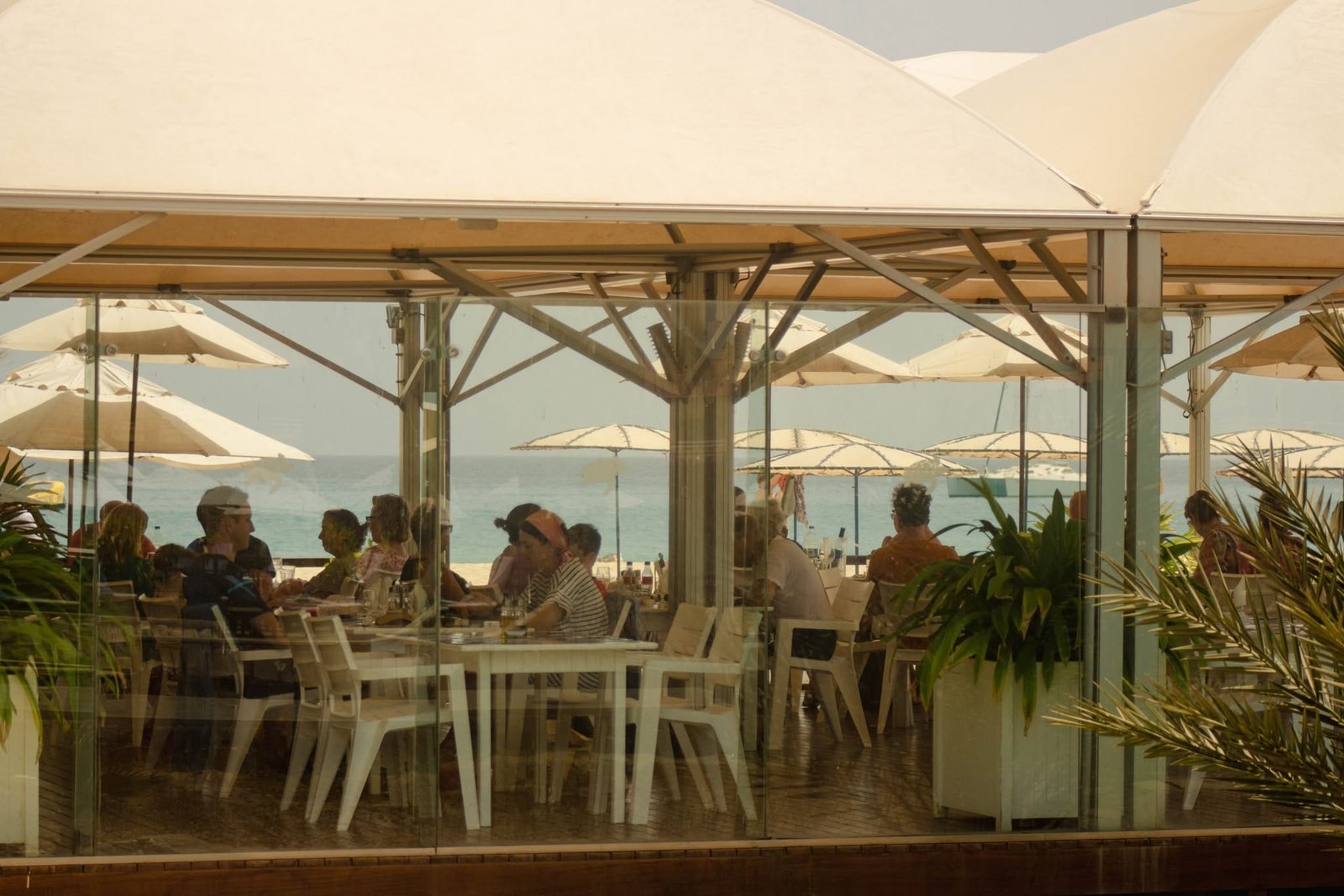
Santa Maria Town and Culture
Today, Santa Maria is a vibrant and relaxed town that balances its Cape Verdean heritage with a cosmopolitan atmosphere shaped by tourism. The town centre is small, compact and easily walkable, centred around Praça Marcelo Leitão, a central square near the beachfront, and the adjoining Rua 1º de Junho, lined with shops, cafes, and restaurants.
Low-rise buildings painted in sun-faded hues of blue, yellow, and pink give Santa Maria a cheerful, island-style architecture rather than grand colonial monuments.
One notable landmark is the modest Church of Nossa Senhora das Dores (Our Lady of Sorrows), a simple Catholic church located near the town centre – its bell tower and Portuguese-tiled facade reflect the community’s religious roots, and on Sunday mornings locals gather here for Mass, sometimes spilling out into the adjacent streets.
Cape Verdean Culture
Local Cape Verdean culture is alive in Santa Maria’s music, food, and festivals. Strolling after sunset, one might hear soulful morna or upbeat coladeira music wafting from bars, or see groups of locals practising the fast-paced funaná dance. In fact, Santa Maria hosts an annual Beach Music Festival every September, a multi-day celebration with live concerts on the sand, drawing artists from across the islands. Throughout the year, the community also observes traditional religious feasts (for saints like Santa Cruz and Santo António) with processions and gatherings.
Despite the influx of resorts, many Santa Maria residents maintain a traditional lifestyle: fishermen unload their catch at dawn, and elders chat in Crioulo on benches by the square. The blend of locals and newcomers has created a welcoming vibe – the Creole word “morabeza” is the name for the traditional hospitality and openness of Cape Verdeans.
Fusion of Cultures
Tourism has brought diversity: a sizable expatriate community (Europeans, Africans from neighbouring countries, etc.) lives here seasonally to work in hotels, dive shops, or restaurants. As a result, Santa Maria offers an international dining scene (from Italian pizzerias to Indian curry houses), alongside Cape Verdean eateries serving fresh grilled seafood, cachupa (the national corn and bean stew), and grogue (sugarcane rum).
The fusion of cultures is also seen in art – colourful street murals decorate walls around town, depicting themes of ocean life and Creole identity, adding an open-air gallery feel to Santa Maria’s streets.
Visitors can learn about local crafts and traditions at places like Funaná – Casa da Cultura, a combined living museum and restaurant. Housed in a replica of a traditional straw-roofed building by the beach, Funaná offers daytime tours with demonstrations of Cape Verdean cooking and music, and by night transforms into a lively venue with folk dance shows and buffet dinners. This provides an accessible way for travellers to experience Cape Verde, from sampling couscous and grogue to watching the hypnotic gyrations of the funaná dance.
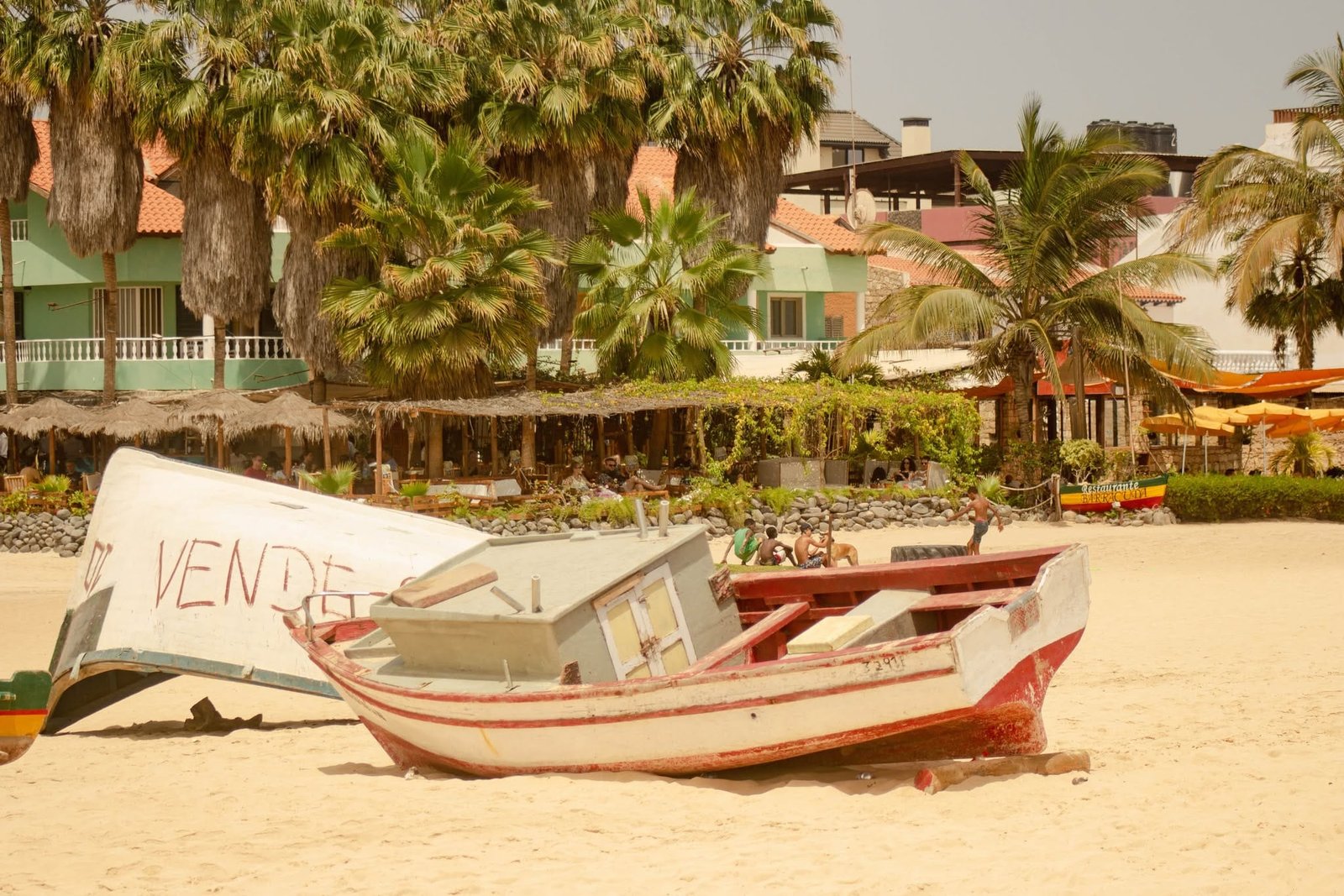
Most Popular Places
Praia de Santa Maria (Santa Maria Beach)
The crown jewel of the town is its namesake beach – an 8 km (5-mile) stretch of soft, white sand lapped by calm, turquoise-blue water. This beach runs along Santa Maria’s entire frontage, from the Pontão (pier) in the town centre westward to the dunes of Ponta do Sinó. It is widely regarded as one of the finest beaches in West Africa, praised for its scenic beauty and swimming conditions. The southern orientation of the bay means waves are usually gentle, making it ideal for swimming, stand-up paddleboarding, or simply floating in the warm sea (water temperatures stay ~23–26°C).
The beach is also spotless and well-serviced – beach bars and cafés with thatched umbrellas are spaced along the sand, offering cold drinks, seafood snacks, and music. Thanks to the beach’s size, it rarely feels crowded except perhaps right in front of the larger resorts in peak season. Walking the length of Santa Maria Beach is a popular activity: one can stroll for hours on end, passing beach volleyball games and joggers near town, then quieter stretches of sand with only the sound of the surf. Notably, the far western end by Ponta Preta becomes more rugged and wave-exposed, offering a different mood. Santa Maria Beach isn’t just for sunbathing – it’s also a place of ecological significance.
During summer nights (approximately July–October), loggerhead sea turtles come ashore to nest on parts of this coast. Conservation groups lead nighttime turtle walks for visitors to witness nesting (in season) without disturbing these endangered creatures.
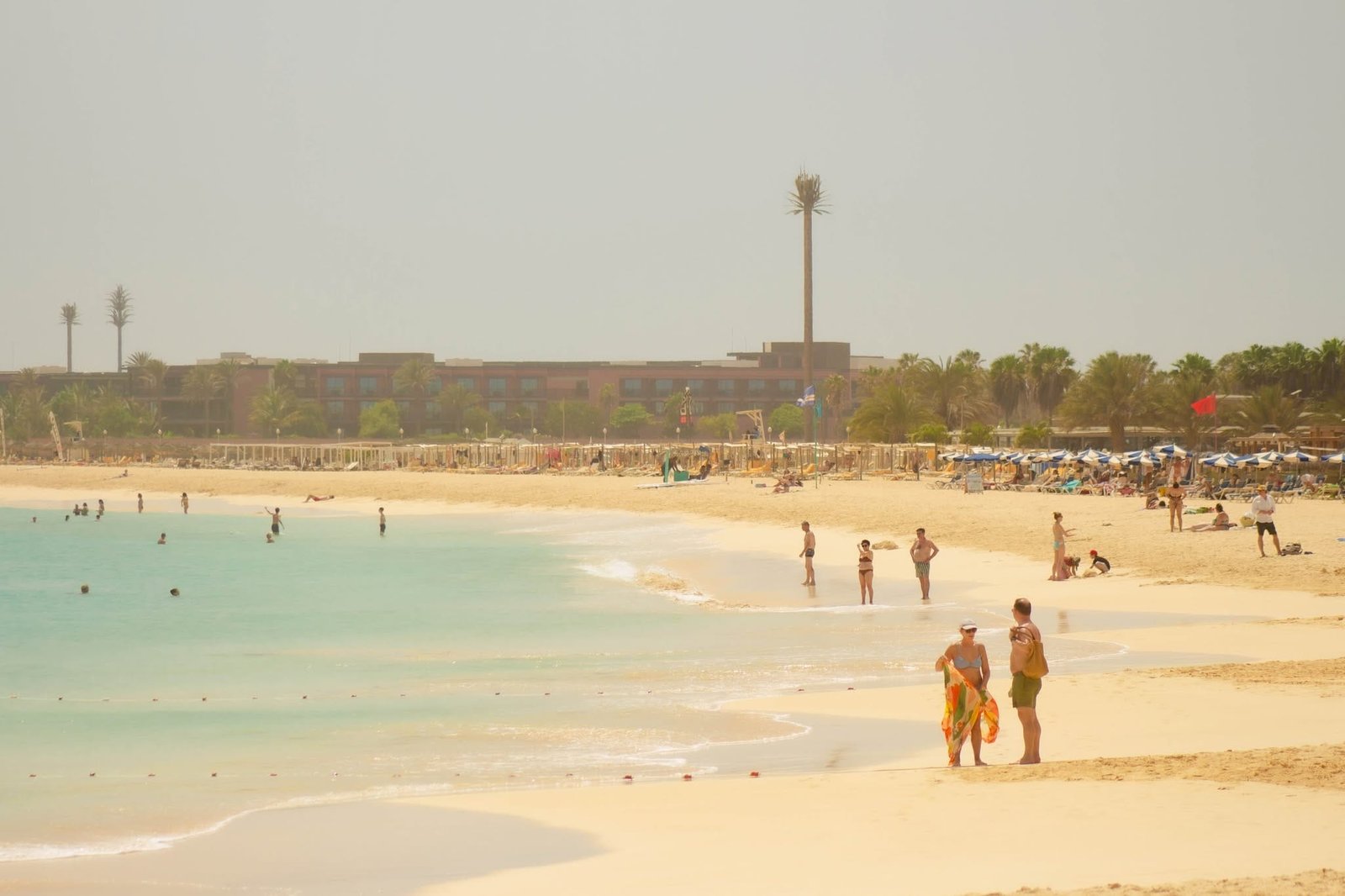
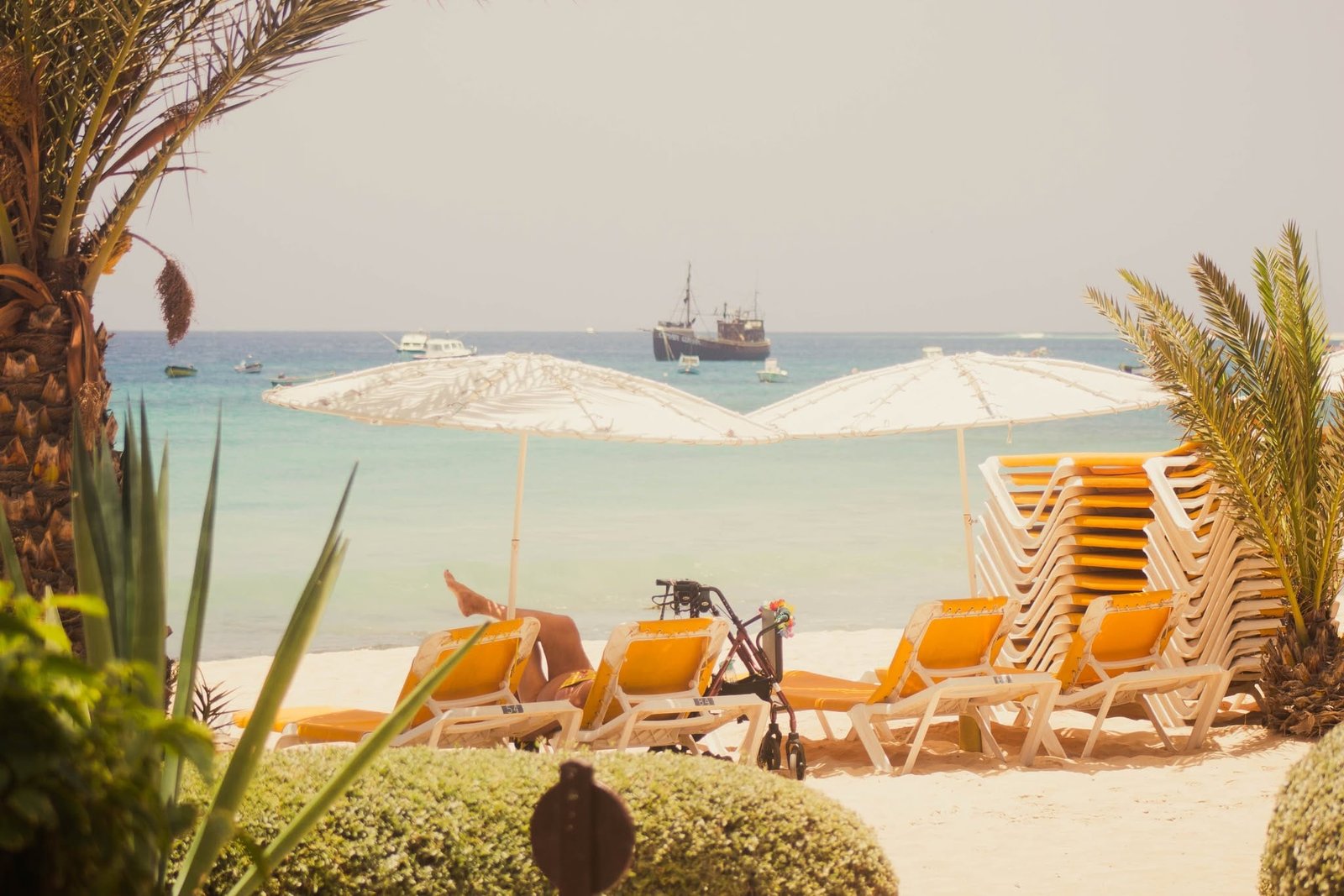
Santa Maria Pier (Pontão)
Extending into the bay from the town centre is a wooden pier – a historic structure that serves as Santa Maria’s social and economic heart. Built in the 1800s for loading salt, the Pontão today is where local fishermen land their daily catch and is an attraction in itself. Each morning, small fishing boats painted in bright colours crowd the pier’s sides, unloading baskets of fresh fish: tuna, wahoo, grouper, lobster and more. In a flurry of activity, women gut and clean the fish on the spot, and buyers (locals and chefs) haggle over prices – a lively scene that gives travellers a taste of authentic island life.
Tourists are welcome to walk out on the pier to watch the action: one can see gleaming fish being scaled, hear Creole chatter and laughter, and even spot fearless needlefish and moray eels in the clear water below.
It’s also common to see kids diving off the Pontão into the sea for fun, especially on hot afternoons.
The pier offers a lovely view back toward Santa Maria’s shore and is a fantastic photo spot, framed by bobbing boats and often a brilliant blue sky. Historical tidbits are noted on a signboard by the pier, reminding visitors that this humble jetty once linked Sal’s salt to the world. As evening falls, the Pontão quiets down and becomes a peaceful place for a sunset walk, with the sky turning orange behind the anchored boats.
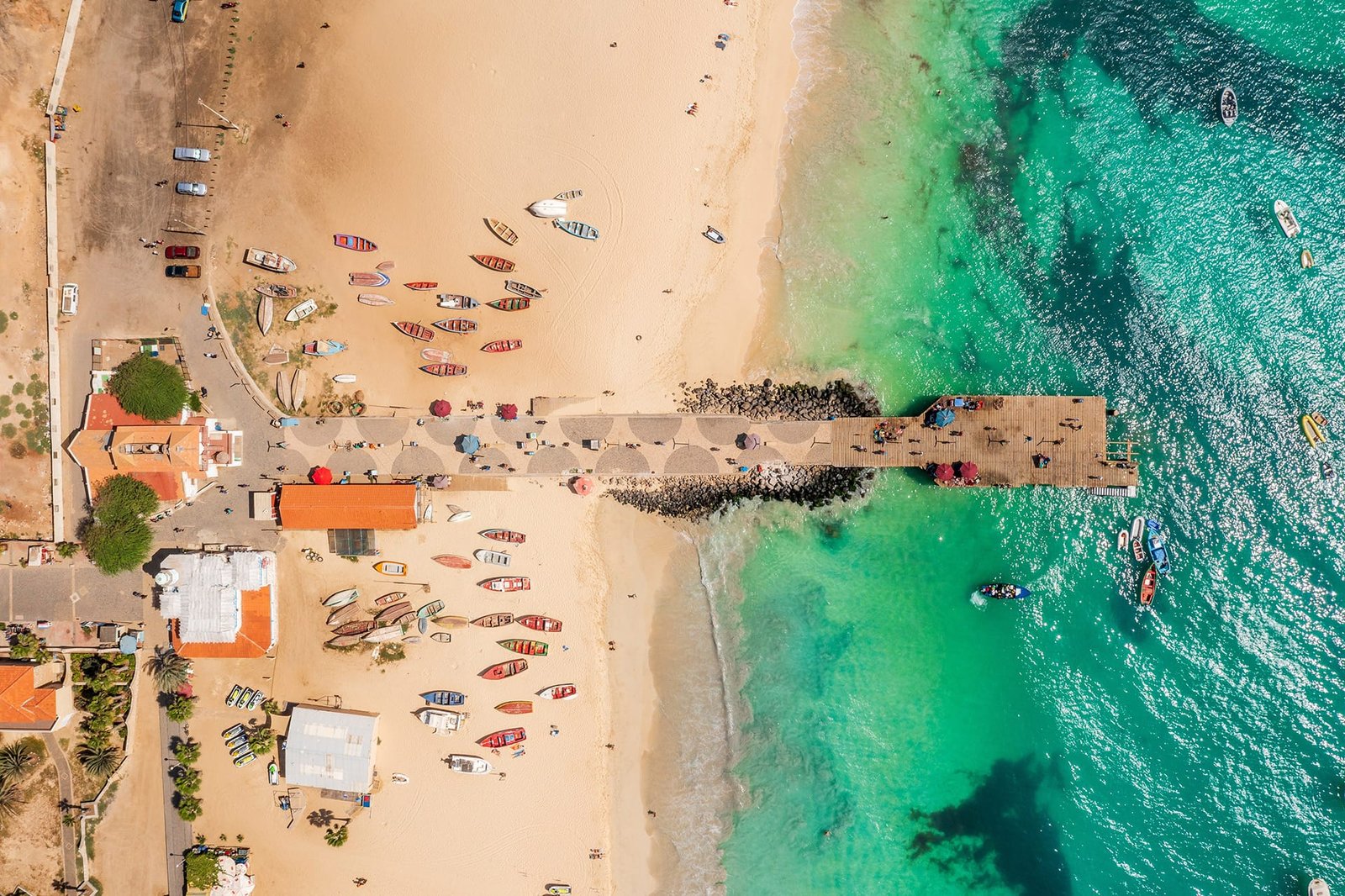
Shell Cemetery Beach (Cemitério das Conchas)
At the far eastern edge of Santa Maria (toward Ponta da Fragata) lies a unique shoreline known as Shell Cemetery Beach. This is a rocky, black-sand beach about a kilometre long, where countless seashells wash up and accumulate, giving the impression of a “graveyard” of shells. Every morning, the tide leaves behind new shells – some large intact conches over 10 cm long, many broken fragments – scattered across the dark volcanic rocks.
Some people walk here at daybreak to collect shells, which they later clean and use as parts of decorations or sell as souvenirs on the pier or in town. For visitors, it’s a tranquil spot to explore tide pools and admire the variety of shellfish remnants glistening in the sun. The juxtaposition of pure white shell pieces against black lava rock makes for striking photographs.
Despite the somewhat eerie name, the beach is not a literal cemetery but rather a natural dump zone for the ocean’s debris (augmented in part by shells discarded from seafood processing). It’s best visited with sturdy footwear due to the rough ground.
On your return walk from the shell beach, you’ll pass a small cove with actual sand where you can dip into the ocean if you wish. The area is undeveloped – only a few boutique accommodations like Budha Beach Hotel sit nearby – so the shell beach offers a stark, undeveloped contrast to Santa Maria’s resort beaches. It’s a reminder of Sal’s raw nature, where the ocean continuously shapes the shore.
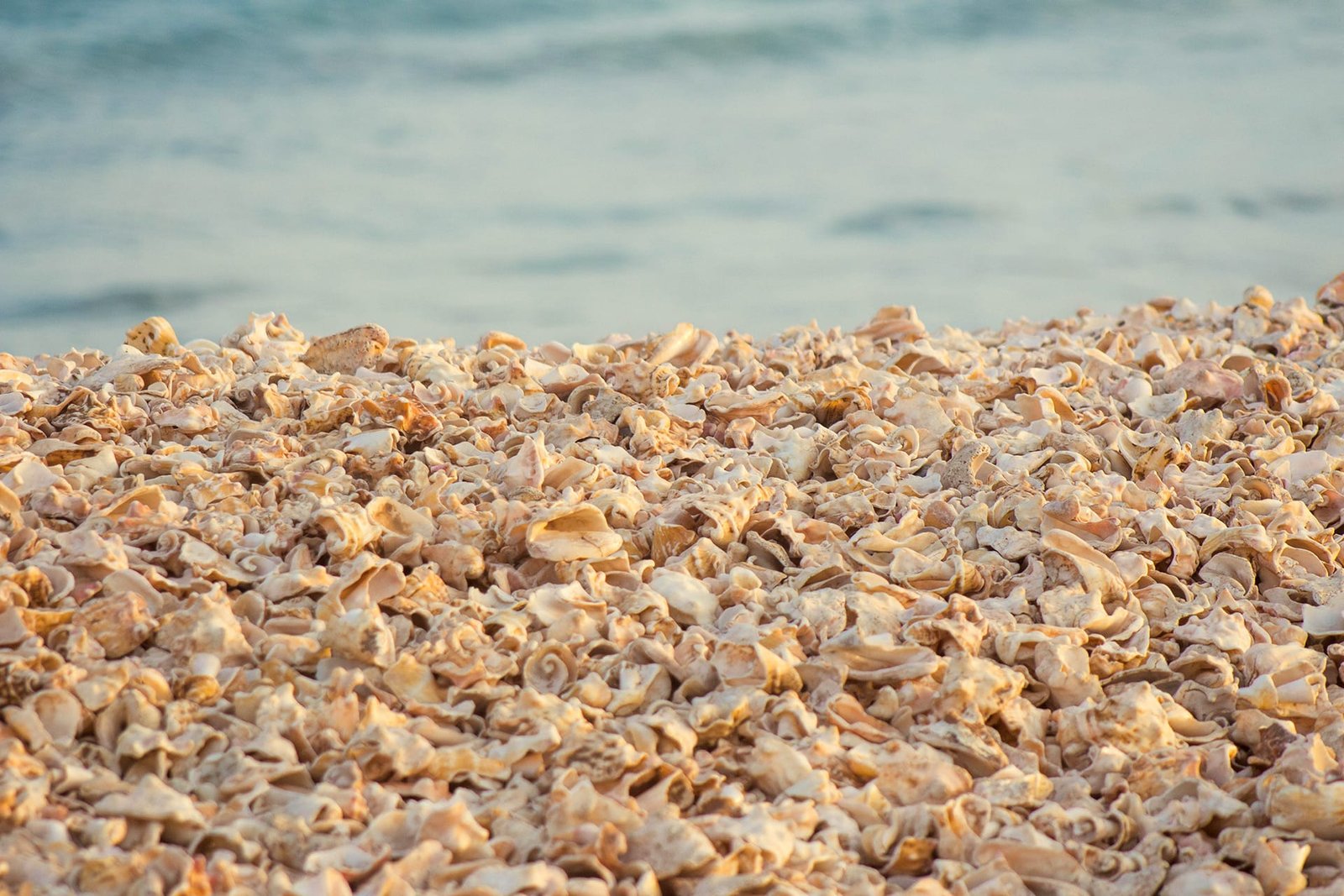
Ponta Preta Beach
On the southwestern outskirts of Santa Maria lies Praia da Ponta Preta, another celebrated beach known for its dramatic waves and sunsets. Translating to “Black Point” (for the dark rocks nearby), Ponta Preta has a different character from the calm town beach. In winter months, Atlantic swells roll in here, creating some of the best wave conditions for surfing and windsurfing in Cape Verde. It’s a venue for international windsurfing events and attracts experienced surfers looking for long, clean waves. The currents and shore break are powerful, so it’s not recommended for swimming when waves are high. Instead, visitors come to Ponta Preta to stroll on the dune-backed sands and watch seasoned windsurfers carve across the waves at high speed.
In contrast to bustling Santa Maria town, Ponta Preta is undeveloped except for one beach club restaurant, so it offers a sense of open space. This beach is also famed for its sunsets – facing due west, it provides an unobstructed view of the sun sinking into the ocean. Many enjoy an evening here with a drink (perhaps the local grogue or a Strela beer) to toast the end of the day. Additionally, Ponta Preta’s dunes are a sea-turtle nesting site, similar to other Sal beaches; access at night may be restricted in nesting season to protect eggs. Whether you’re a surfer or a spectator, Ponta Preta showcases Sal’s wilder side and is only a short taxi or bike ride from town.
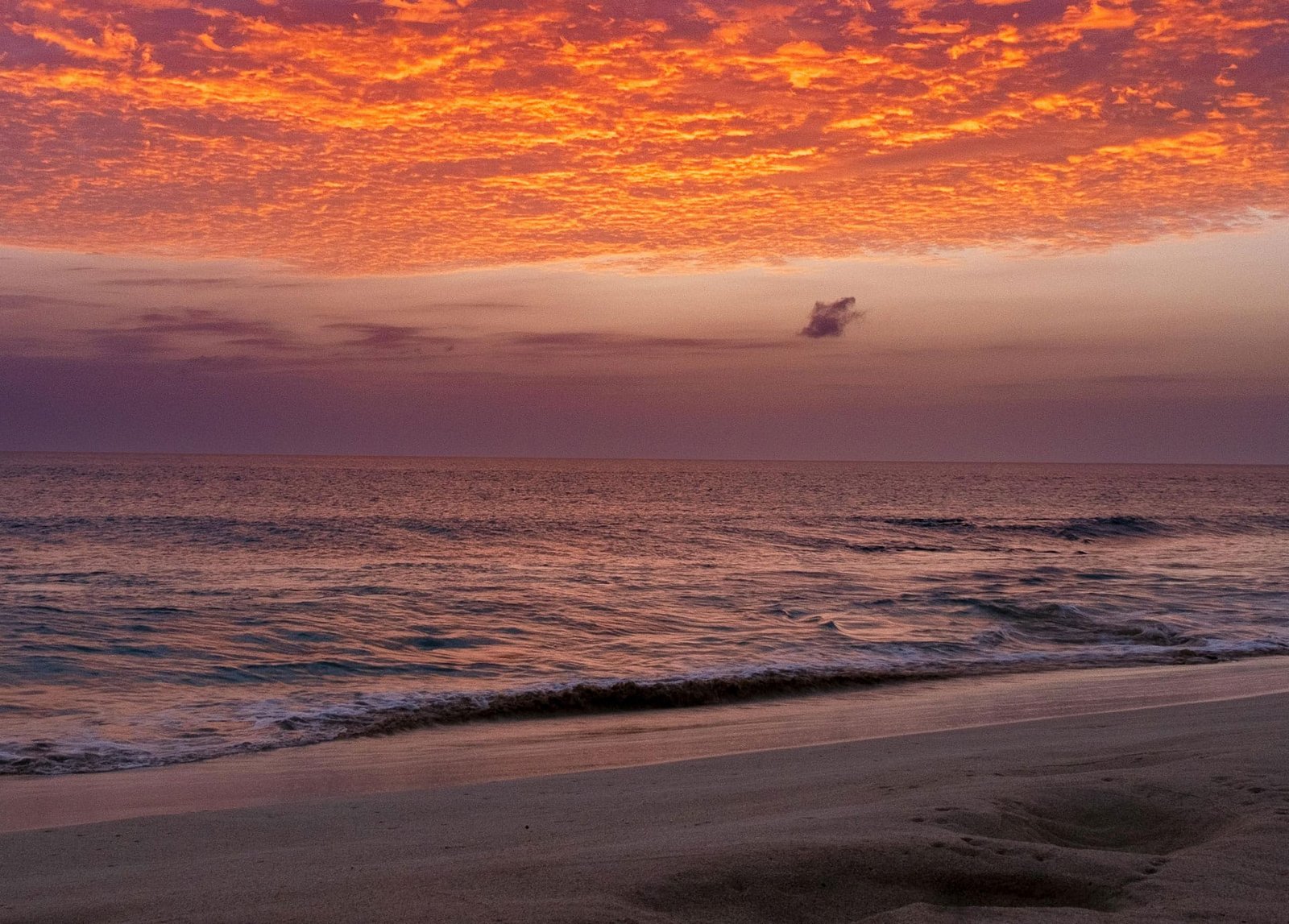
Santa Maria Salt Ponds (Salinas de Santa Maria)
Just north of the town lie the remnants of Santa Maria’s once-thriving salt evaporation ponds. Covering about 69 hectares, these shallow rectangular pans form a patchwork of pink, white, and dusty brown when filled with saline water or dried salt. The Salinas de Santa Maria are protected as a landscape and serve as a historical monument to the island’s salt trade. Visitors can walk or bike to the salt flats (around 1.5–2 km from the town centre) to see the old dikes and mounds of salt crystals.
Informational signs describe how seawater was channelled and evaporated here since the 19th century, yielding the “white gold” that once sustained Santa Maria. Although salt is no longer produced on a large scale, one can still observe local workers occasionally harvesting small quantities by hand, mainly for tourist purchase. Indeed, you can buy locally harvested sea salt at the site or in town – a popular souvenir that connects to Sal’s heritage.
The saltpans are also of interest to birdwatchers: the brine pools attract migratory birds like sandpipers and plovers, and the surrounding marshy spots may hide tiny Cape Verdean geckos and crustaceans adapted to saltwater. For those interested in geology, the contrast of the flat salinas against Sal’s otherwise sandy desert landscape is striking.
Just a 20-minute drive away, near Pedra de Lume village, is another famous salt site – the Pedra de Lume Salt Crater, where visitors can float in dense saltwater inside an extinct volcano. While not in Santa Maria itself, this is a popular half-day trip from town, offering a spa-like experience of buoyancy in mineral-rich waters.
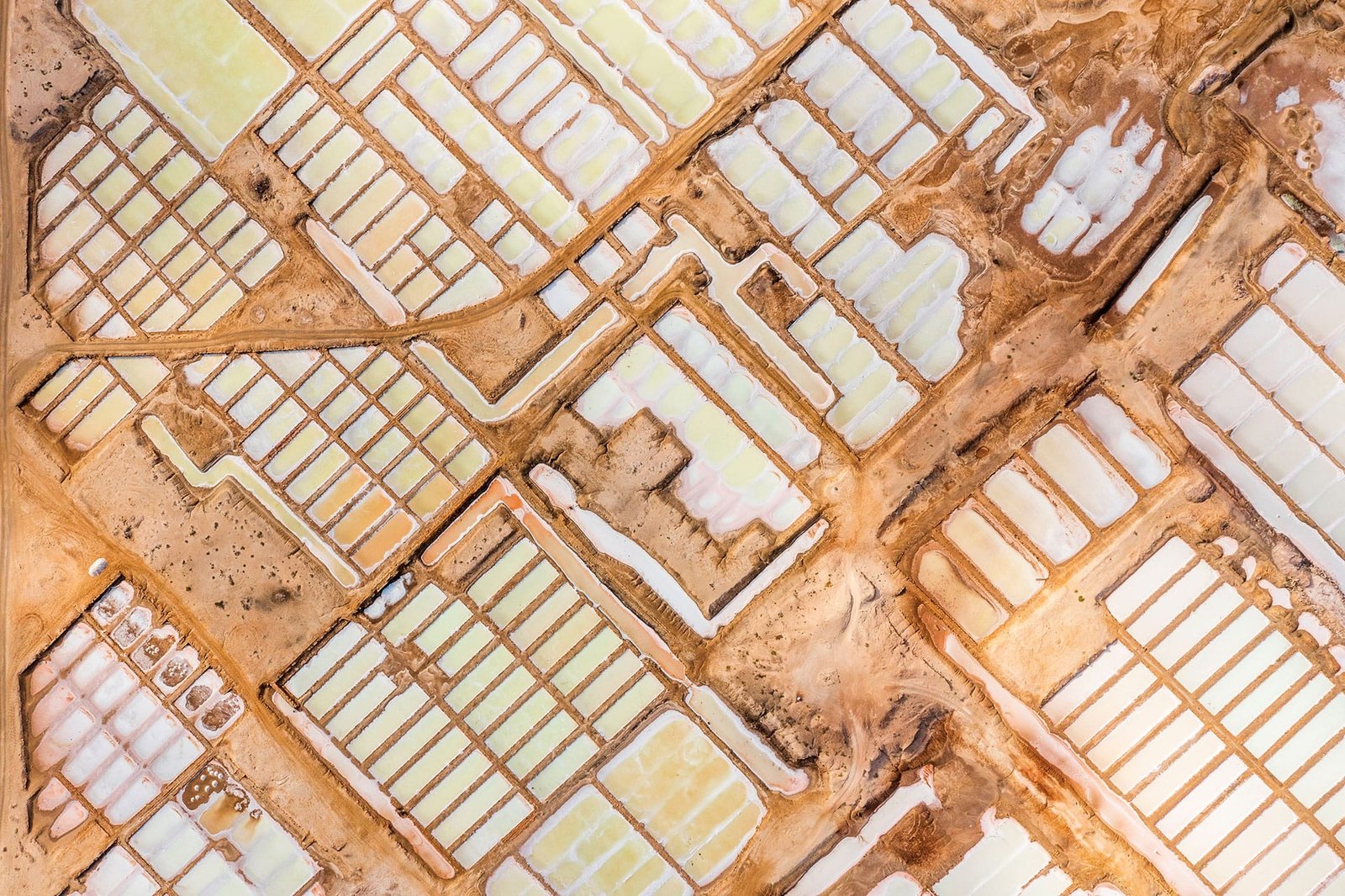
Activities and Attractions
Water Sports
Beyond sunbathing on beaches, Santa Maria offers a wealth of activities for travellers, making it the adventure capital of Cape Verde. Water sports are especially prominent: the town is a top destination for kitesurfing, windsurfing, surfing, sailing, jet skiing, kayaking, and sport fishing. Several reputable water sports centres (including an ION Club and local surf schools) operate on Santa Maria Beach, providing rentals and lessons for all levels. Novices can take a short course to learn windsurfing in the bay’s gentle conditions, while experienced kite-surfers can join downwind excursions along the coast. Scuba diving and snorkelling are also popular; clear waters around Sal teem with marine life like parrotfish, moray eels, rays, and turtles. Dive operators in Santa Maria run daily boat trips to reefs, shipwrecks, and caves (such as the Blue Eye cave at Buracona, on Sal’s west coast). For those who prefer staying above water, big-game fishing charters can be arranged to catch tuna, marlin, or wahoo in the deep seas off Sal. The variety of aquatic adventures means both adrenaline-seekers and families find options – from paddleboarding at sunrise to riding a glass-bottom boat to see reef fish without getting wet.
Land Adventures
On land, the flat desert terrain of Sal lends itself to off-road exploring. Visitors can rent quad bikes (ATVs) or join guided buggy tours that zoom across the island’s dunes and saline flats, reaching places like Kite Beach, the saline crater, or the mirage at Terra Boa. These excursions are a thrilling way to see Sal’s moon-like landscapes, kicking up dust on the red and white sand plains. Mountain bikes are also available for hire in Santa Maria – an eco-friendly way to explore the surroundings at your own pace. A popular cycle or jogging route is the coastal track from Santa Maria to Ponta Preta and further north along the coast, offering breezes and ocean views. If you prefer something more relaxed, horseback riding is offered at a ranch just outside town, where you can trot along the beach at sunset.
Natural Wonders
For nature and wildlife enthusiasts, Santa Maria is a convenient base to experience Sal’s unique natural sights. Guided tours can take you to Shark Bay (15 km from town), where you can wade in knee-deep water among wild baby lemon sharks – a safe yet exhilarating encounter in a natural nursery lagoon.
The island’s Viveiro Botanical Garden & Zoo is only 3 km from Santa Maria: this oasis, also called Pachamama Eco Park, showcases green gardens, native and exotic plants grown with recycled water, and a petting zoo with some farm animals and a few wild species. It’s a delightful break from the beach to see thriving vegetation (in contrast to Sal’s usual aridity) and learn about local sustainability efforts. The gardens have shaded paths and a café, making it a nice family-friendly outing.
Hikers or bird-watchers might venture to Serra Negra (the island’s highest hill, about 15 km east) – guided walks up this hill at dawn are rewarded with panoramic views over Santa Maria and spotting of seabirds in the protected coastal reserve below.
In essence, whether one’s interest is adventure, nature, or culture, Santa Maria provides a gateway to experience it, either within town or through short excursions around Sal Island.
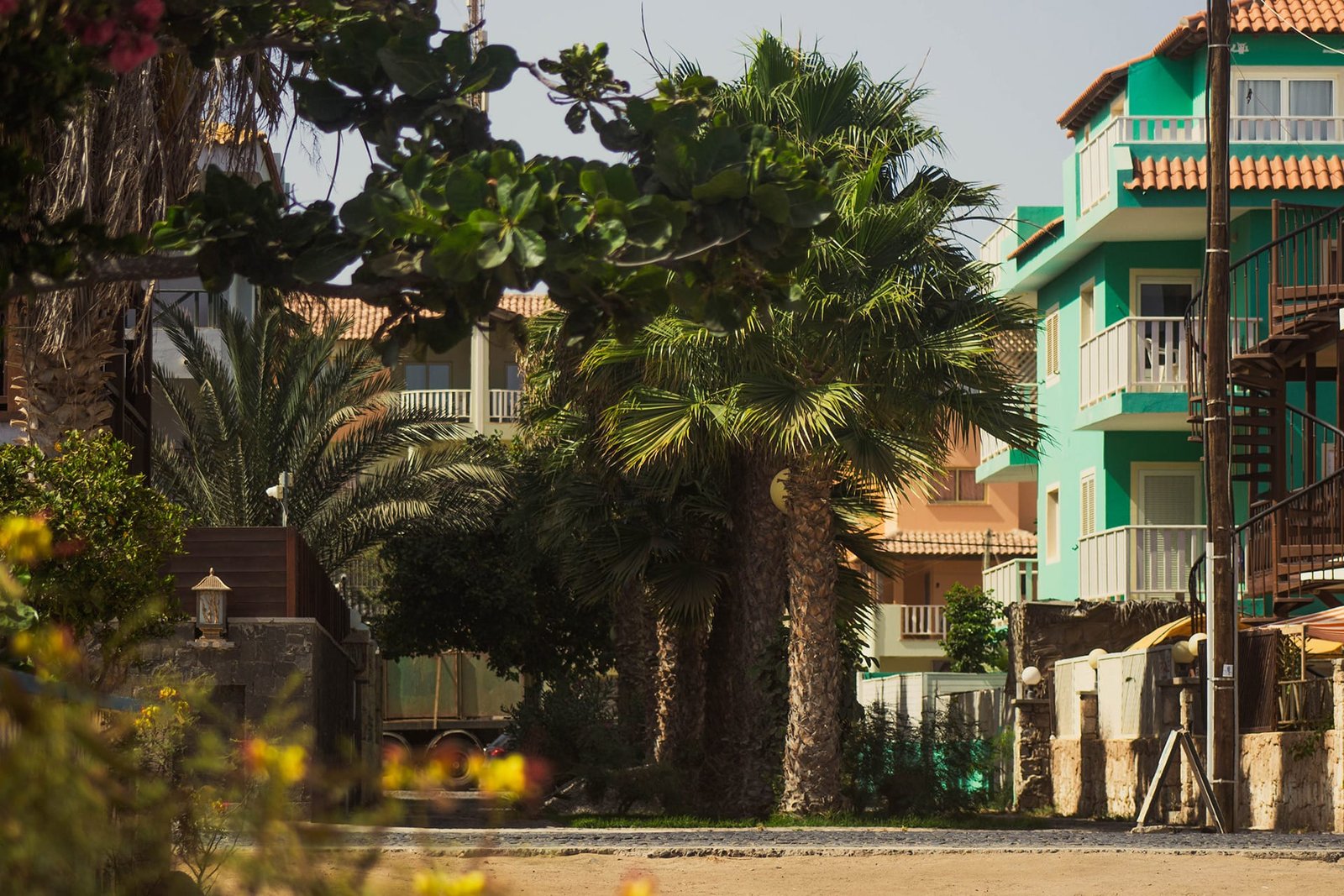
Nightlife and Entertainment
While evenings in Santa Maria are relatively low-key compared to big cities, the town does boast a fun and varied nightlife that reflects its musical soul. After dark, the beachfront and main street come alive with a mix of venues, including live music bars, dance clubs, beach clubs, and hotel lounges. Many resorts host their entertainment (like traditional dance shows or acoustic bands), but visitors should also explore the local bars in town for a more authentic scene.
Live music is a highlight. Spots like Buddy Bar or Ocean Café regularly feature live bands playing Cape Verdean morna, reggae, or acoustic cover songs in the early evening. It’s common to see tourists and locals alike swaying to morna’s melancholic melodies or clapping to upbeat coladeira rhythms with a caipirinha in hand. Later at night, a few dance clubs and late-hour bars get going – for example, Pub Calema on the main strip is known for its lively atmosphere and Afro-beat tunes, while Pirata (a nightclub) and the newer Club One near the town entrance offer DJs and dancing into the small hours. These clubs play a wide variety of genres, from kizomba and funaná (local music) to international pop, Latin, disco, hip hop and trap music, catering to a diverse crowd.
Overall, Santa Maria’s nightlife is friendly and casual. There’s no strict dress code – beachwear and sandals by day give way to smart-casual outfits at night, but the vibe remains unpretentious. Many bars have outdoor terraces so that one can enjoy warm tropical nights under the stars. A notable venue is Funaná – Casa da Cultura, mentioned earlier, which, by night (certain evenings), hosts buffet dinners with live folklore performances; it turns into a bit of a party with guests invited to dance once the cultural show ends. For a more laid-back evening, some prefer beachfront lounges like the Sal Beach Club or hotel bars such as Morabeza’s Tortuga Bar, where you can sip local Fogo wine or grogue cocktails while listening to soft guitar music and the sound of waves. Weekly events include karaoke nights, open-mic jams, and occasionally international DJs, especially during holiday seasons.
It’s worth noting that Santa Maria’s nightlife typically peaks around 10 pm to midnight – outside of the one or two nightclubs, most places quiet down before 2 am, in line with the island’s relaxed pace. As one travel guide puts it, nightlife here is “low key but enough to keep you entertained,” centred on enjoying music and good company rather than wild partying. Whether you choose to dance to Creole beats, lounge on a bar terrace, or take a moonlit beach walk, Santa Maria offers a charming end to each day in paradise.
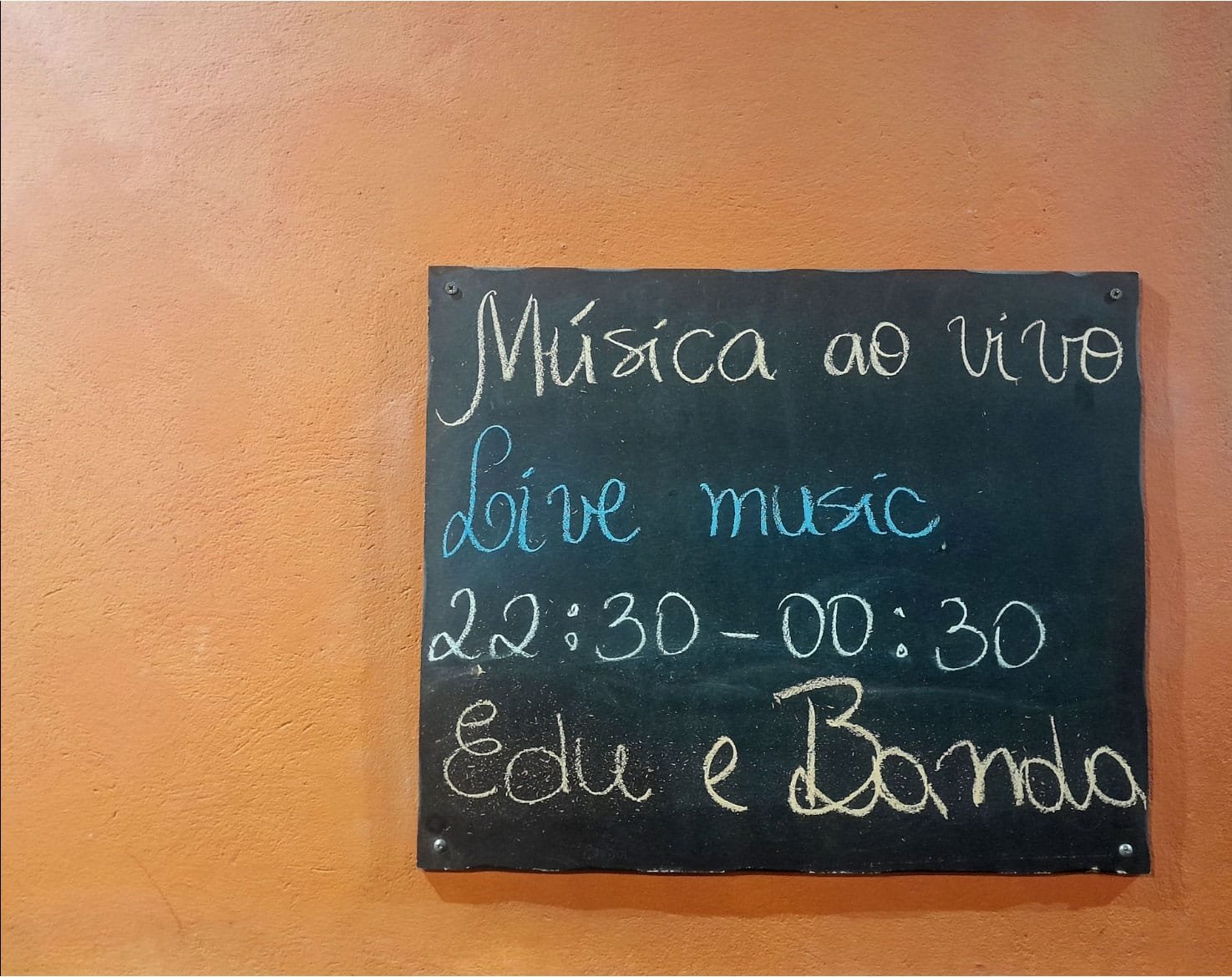
Shopping and Souvenirs
Santa Maria has an array of shops and markets where travellers can pick up souvenirs, local products, and everyday items. The town’s main shopping area is along Rua 1º de Junho and the streets radiating from the pier. Here you’ll find boutiques selling beachwear, surf shops, and several artisan craft shops.
A notable stop is the Mercado Municipal (Municipal Market), a two-story market building that hosts small vendors of handicrafts, artworks, and some local goods. Stalls here and in the nearby Mercado de Artesanato offer a variety of items: handmade jewellery, woven baskets, batik textiles, wood carvings, painted Cape Verdean canvases, drums, and decorative sea salts packaged from Sal’s salinas.
One recommended shop is Djunta Mo Art, a cooperative selling authentic Cape Verdean crafts made by local artisans – purchasing there supports community projects and ensures the items (like pottery, beadwork, or coconut crafts) are genuinely locally made.
Tourists should be aware that not all souvenirs in Santa Maria are Cape Verdean in origin. Many of the wooden masks, ebony statues, or colourful paintings for sale are imported from West African countries (Senegal, Ivory Coast, etc.). You will likely encounter numerous street vendors – often West African immigrants – who set up tables or approach visitors on the beach to sell such crafts. These vendors can be persistent but are generally friendly. While these informal sales are technically unlicensed (hence sometimes referred to as “illegal” sellers by locals), they have become a fixture of Santa Maria’s tourist scene. If you engage, do so with respect – even if you don’t purchase, a polite “no, thank you” (or “não, obrigado” in Portuguese) will usually suffice.
It’s worth noticing that the popular “no stress” motto doesn’t have a Cape Verdean origin – it’s an implemented commercial catchphrase and not an actual piece of local culture.
For those keen on locally produced goods, consider picking up some grogu (sugarcane rum) or Fogo Island wine at licensed shops, or a packet of coarse sea salt harvested from Sal’s pans. There’s also locally made goat cheese and coffee from other islands available in gourmet stores. Clothing and accessories emblazoned with “Cape Verde” or the national flag (t-shirts, caps, sarongs) are ubiquitous and make easy gifts.
One charming shopping experience is the fish market by the pier each morning – not for souvenirs, but to witness locals buying fresh fish. Even if you’re not cooking, seeing giant tuna or wahoo being sold is part of the cultural experience, and sometimes you can buy some filleted fish and have a nearby restaurant cook it for your lunch.
Another spot, the “Genuine Cabo Verde” shop, offers a curated selection of higher-quality souvenirs and Cape Verdean coffee, books, and music CDs. Wherever you shop, remember to carry some cash (Cape Verdean escudos or euros – both widely accepted in tourist areas) as smaller vendors often don’t take cards. Taxi drivers, spa therapists, and street sellers may also accept euro notes for convenience. By patronising the various markets and shops in Santa Maria, visitors support the local economy that so warmly welcomes them.
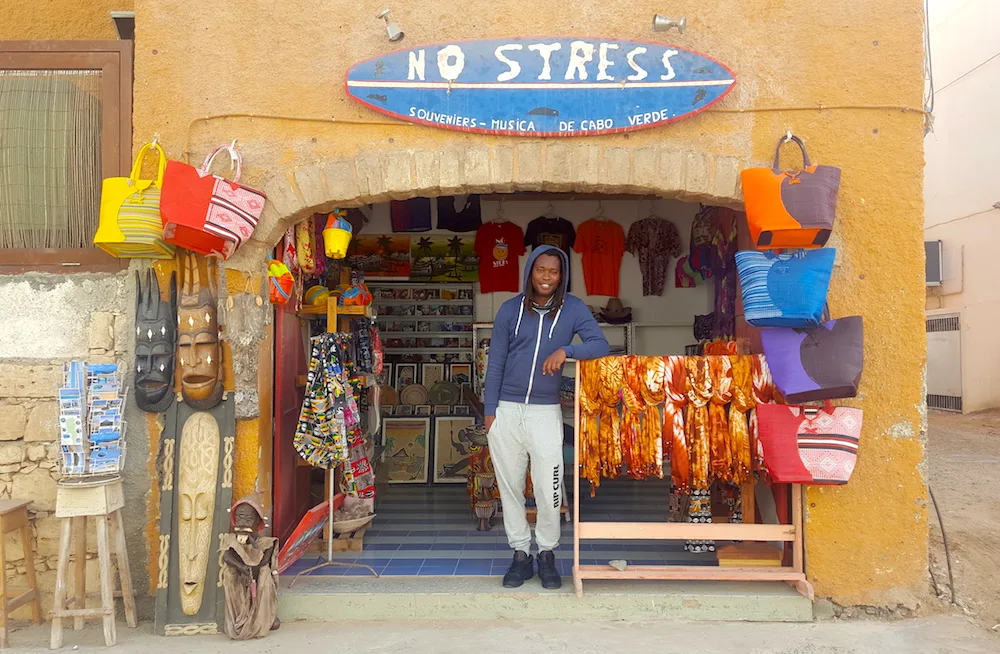
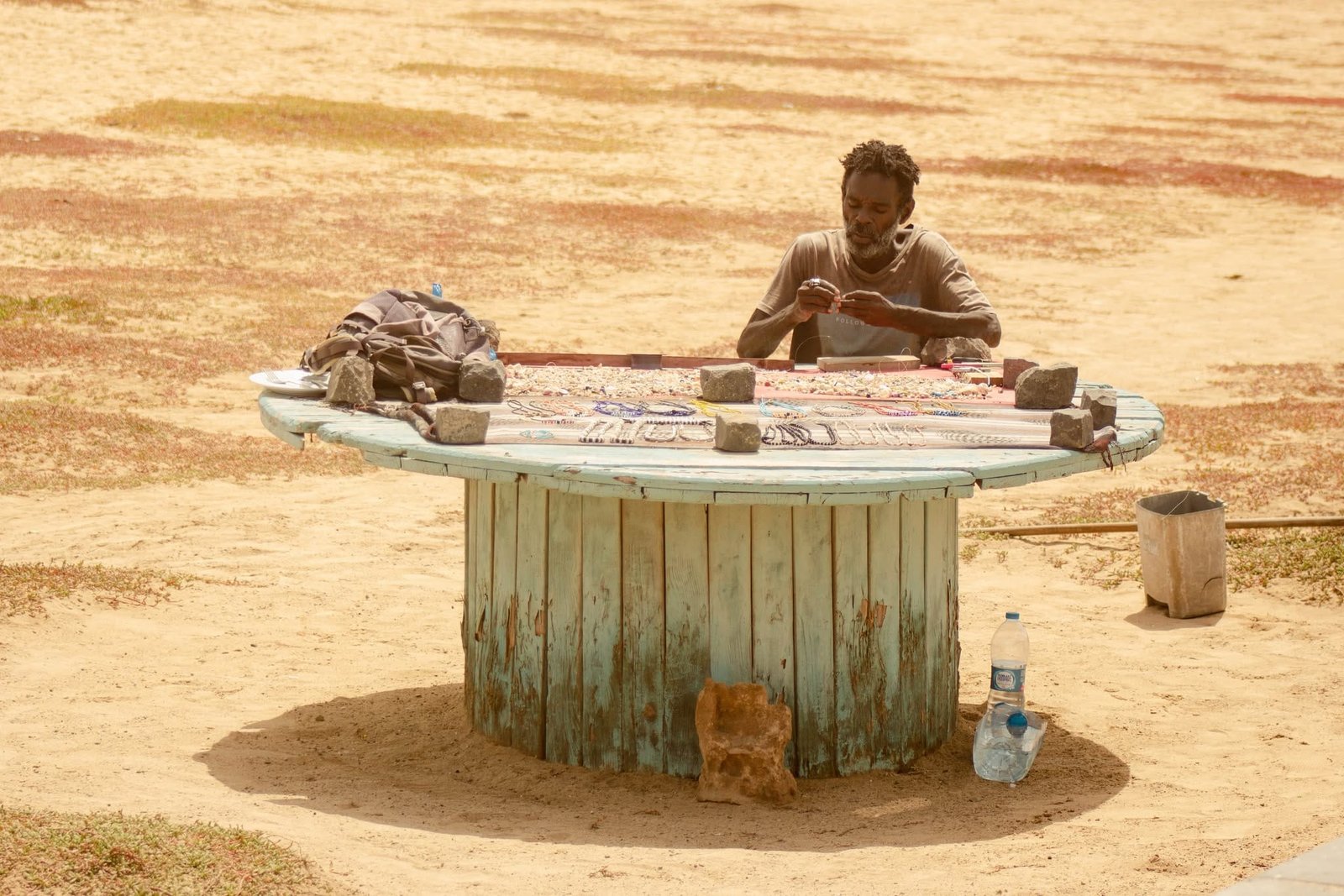
Wellness & Relaxation
Santa Maria provides many options for wellness and relaxation. Many of the larger resorts and hotels in the area feature on-site spa facilities, open to their guests and often to outside visitors for a fee. For instance, the upscale Hilton Cabo Verde Sal Resort boasts a full-service spa with massage therapies, a steam room, and beauty treatments, as well as a beachfront yoga pavilion. Similarly, Melia and Riu resorts in the Ponta Sinó area have wellness centres offering everything from hot stone massages to pedicures. Suppose you’re not staying at these properties. In that case, you can usually book treatments as a day client – it can be a nice way to spend a breezy afternoon out of the sun, indulging in a creole coffee scrub or an aloe vera wrap (aloe grows on some islands and is used in local skincare).
Independent massage studios and beauty salons can be found in town as well. They offer services such as deep-tissue massage, aromatherapy, facials, and hair braiding at generally lower prices than the hotels. Look for minor signs around the main street or ask your hotel for a recommended therapist – Cape Verdean or expatriate professionals run many. One unique wellness experience on Sal is the salt floatation at Pedra de Lume salt crater (about 20 km from Santa Maria): floating in the dense salt lake is reputed to have therapeutic benefits for the skin and joints, akin to a natural spa. Excursions to the salt crater often include a chance to coat yourself in mineral-rich mud and rinse off, leaving skin refreshed. After active days of swimming, kiting, or quad-biking, a bit of spa time can be the perfect complement to a Santa Maria holiday.
Lastly, the simple wellness pleasures are free in Santa Maria: morning beach yoga classes often spontaneously gather at sunrise, jogging along the firm sand by the water’s edge, or just meditating to the sound of the Atlantic waves. With its slow pace and natural beauty, the town inherently encourages visitors to unwind and rejuvenate.
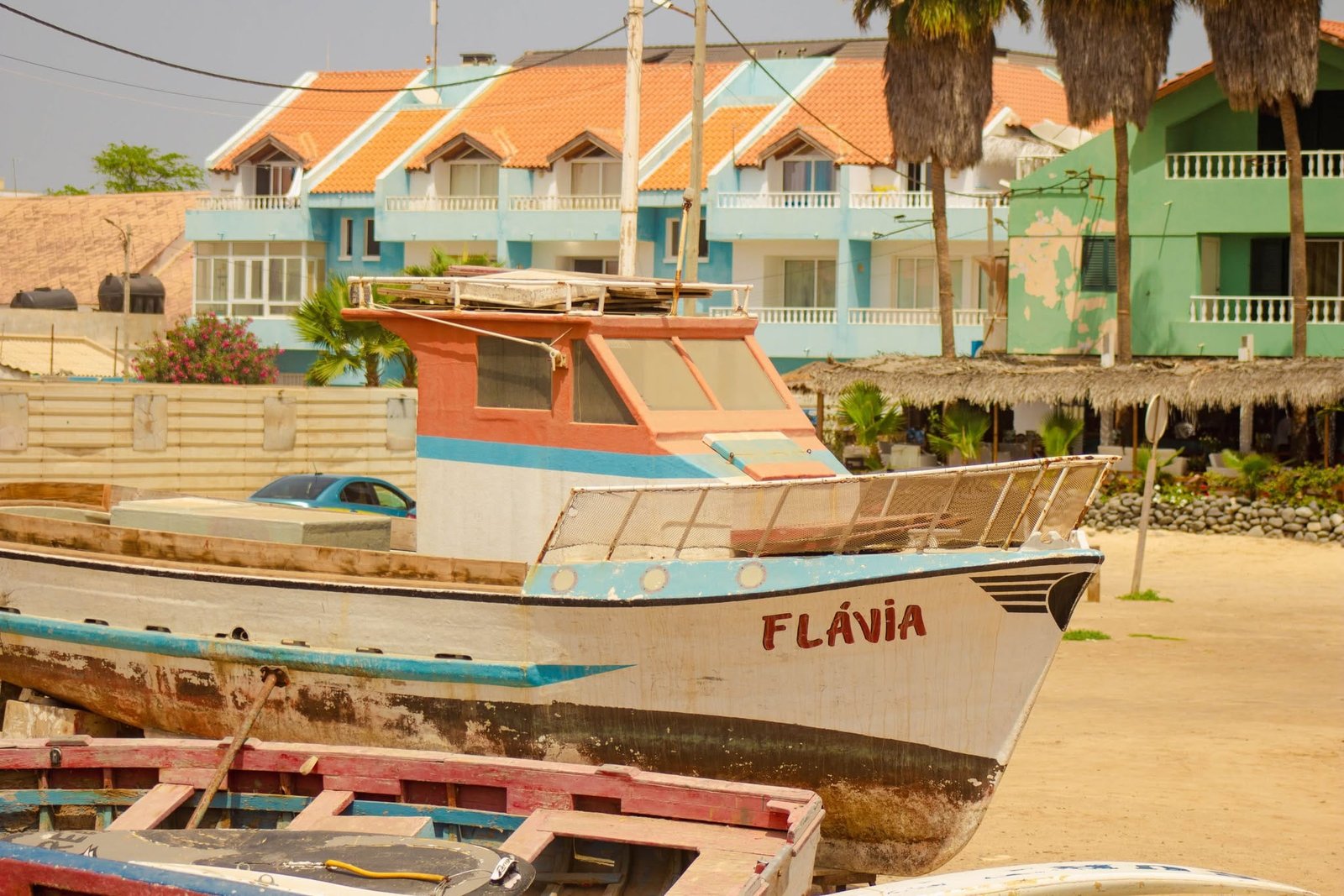
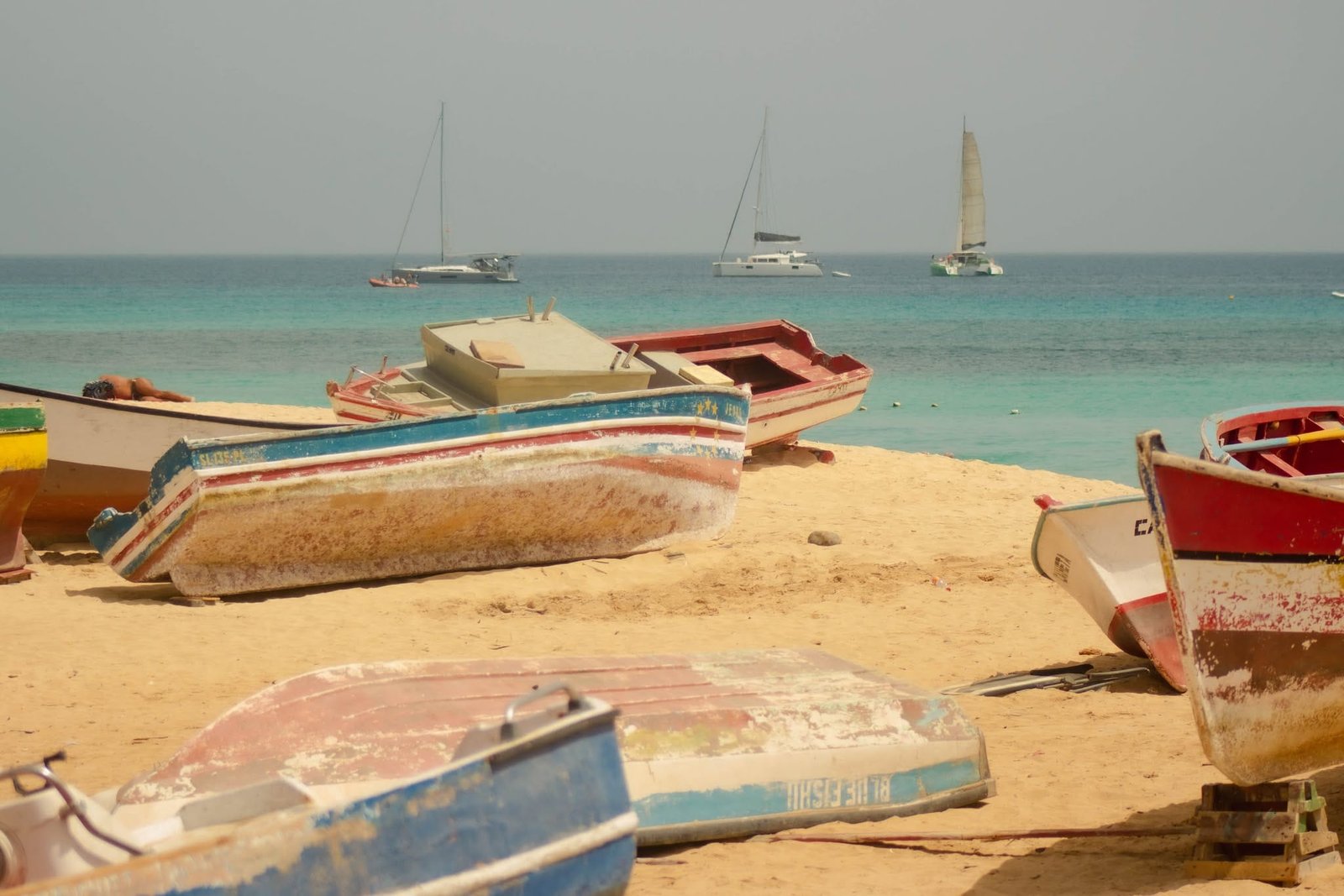
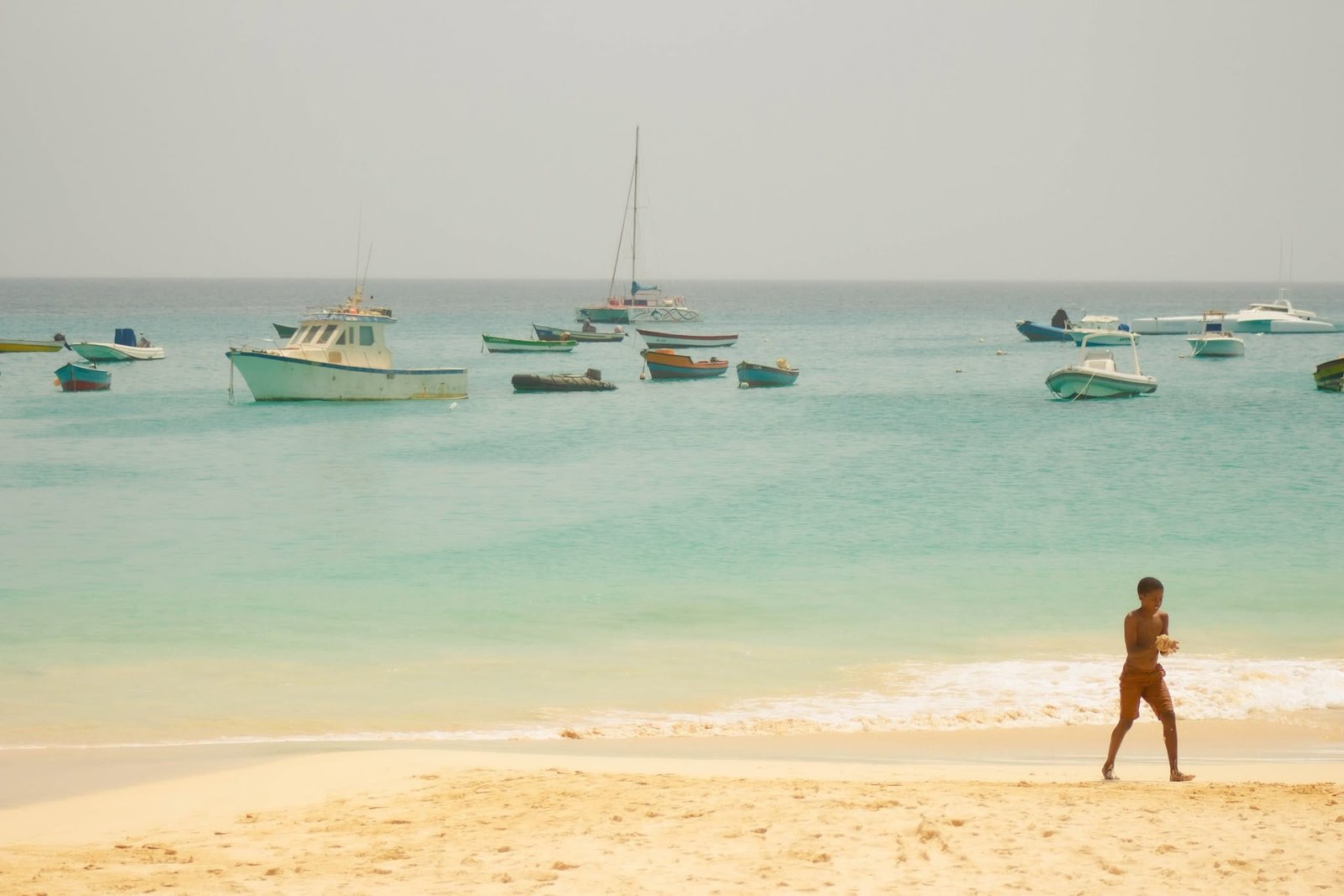
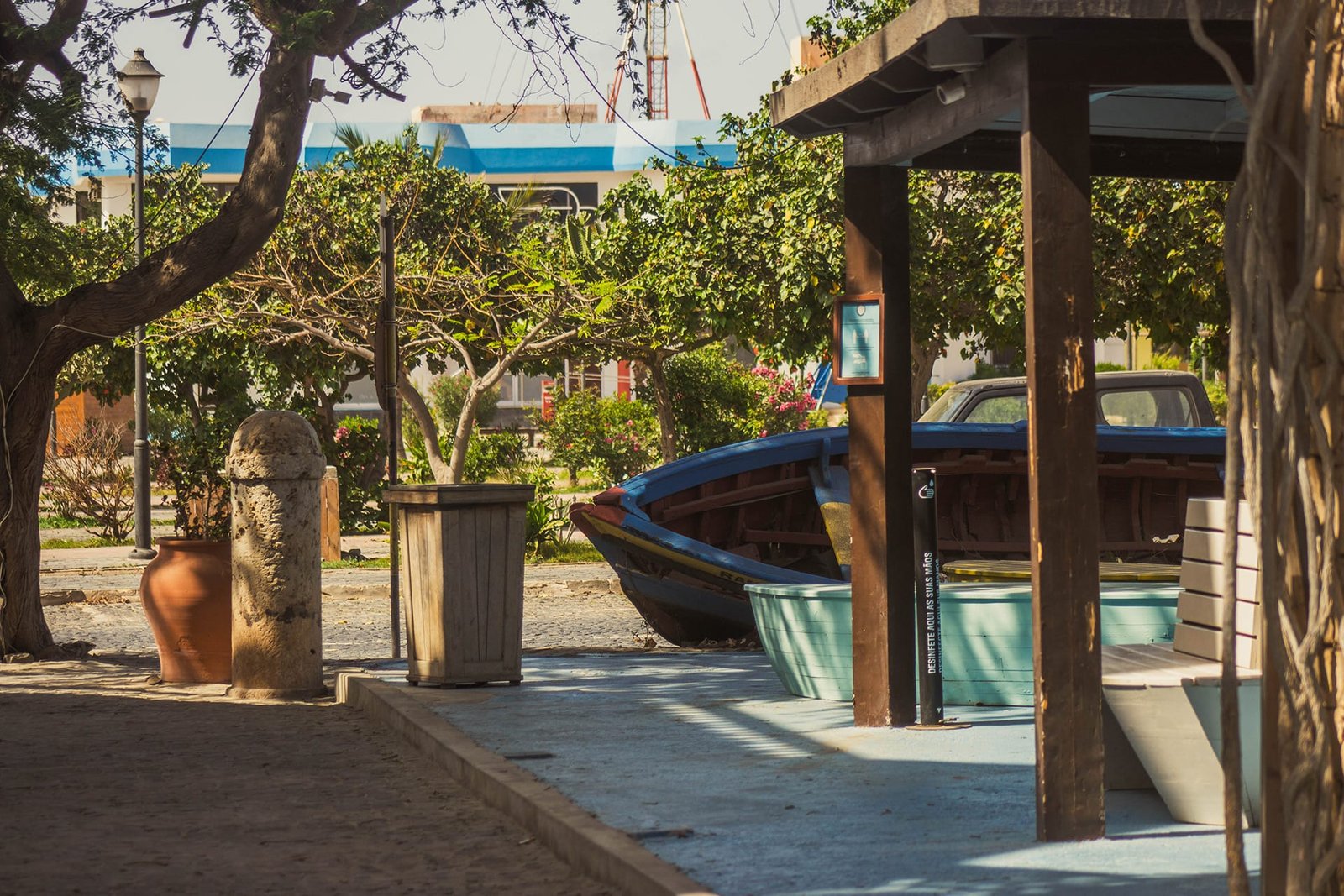
Bibliography
- Santa Maria, Cape Verde on Wikipedia. The Free Encyclopedia;
- Picture of the ,,no stress” souvenir shop via www.thelondoneconomic.com;
- História da Ilha do Sal, Câmara Municipal do Sal;
- “INE Estatísticas do Turismo 2017” (PDF) (in Portuguese);
- Personal notes from the stay, talks with locals.


